Family : Orchidaceae

Text © Prof. Pietro Pavone

English translation by Mario Beltramini
Cattleya percivaliana (Rchb.f.) O’Brien (1883) is a species of the family Orchidaceae, subfamily Epidendroideae, tribe Epidendreae, subtribe Laeliinae.
Recent phylogenetic studies on the subtribe Laeliinae have radically changed the delimitation of the genus Cattleya to which have been included all the species of the genus Sophronitis and the Brazilian species of Laelia.
Cassio van den Berg (Phytotaxa 2014, 186: 75-86) has subdivided the genus Cattleya into four subgenera (Cattleya, Cattleyella, Intermediae, Maximae), three sections (Cattleya, Crispae, Lawrenceanae) and five series (Cattleyodes, Hadrolaelia, Microlaelia, Parviflorae, Sophronitis). In accordance with that Cattleya percivaliana falls into the subgenus Cattleya section Cattleya.
Cattleya percivaliana is a species endemic to the north-western mountains of Venezuela (States of Tachira, Trujillo, Merida and of Lara), present also in the nearby Colombia. It grows on the trees and on the rocks covered by moss, in very luminous and sunny sites with high air humidity, typically on the bottom of valleys, along the rivers, between 1400 and 2000 m of altitude.
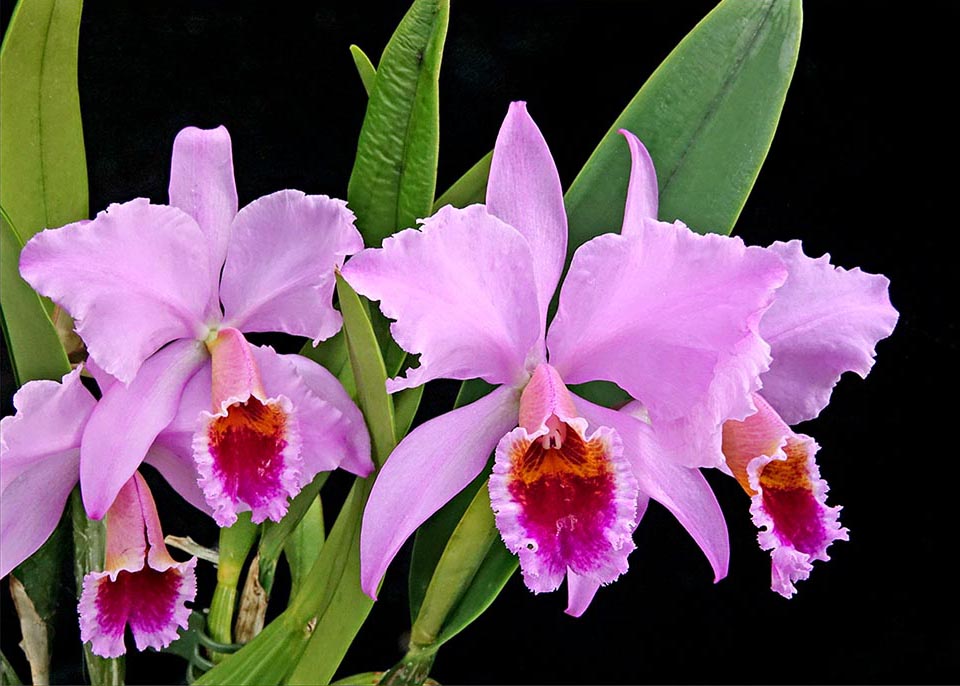
Cattleya percivaliana is endemic to north-western Venezuelan mountains, present also in nearby Colombia between 1400-2000 m of altitude © Emmi Mattes
The plant was discovered in 1881 by the professional collector William Arnold during one of his expeditions in Venezuela, in the Cordillera of Mérida, close to the lake of Maracaibo, at an altitude of 1300 metres above the sea level; in particularly humid areas in a warm and foggy climate.
Arnold was working for the plant nurseryman Henry Frederick Conrad Sander (1847-1920), known also as the king of the orchids of Saint Alban (Hertfordshire, England), who, with his 23 collectors all around the world (half of them dead on the job, including William Arnold, who drowned in the river Orinoco, in South America) between 1880 and 1890 imported in his nursery more than two million orchids. As soon as discovered, Arnold, convinced of having found a new species of orchids, sent to Sander about 20 specimens who has hastened to send them to his friend and botanical consultant Heinrich Gustav Reichenbach (1823-1889) for the correct botanical description.
However Reichenbach did not feel to consider these specimens as members of a new species but only a variety saying that the flowers he had received were not indicative for a good species. As a matter of fact, in June 17th 1882 he presented to the editors of the horticultural periodical The Gardeners’ Chronicle the description of Cattleya labiata var. percivaliana Rchb.f. he dedicated to Mr. R.P. Percival, of Cleveland, well-known English grower.
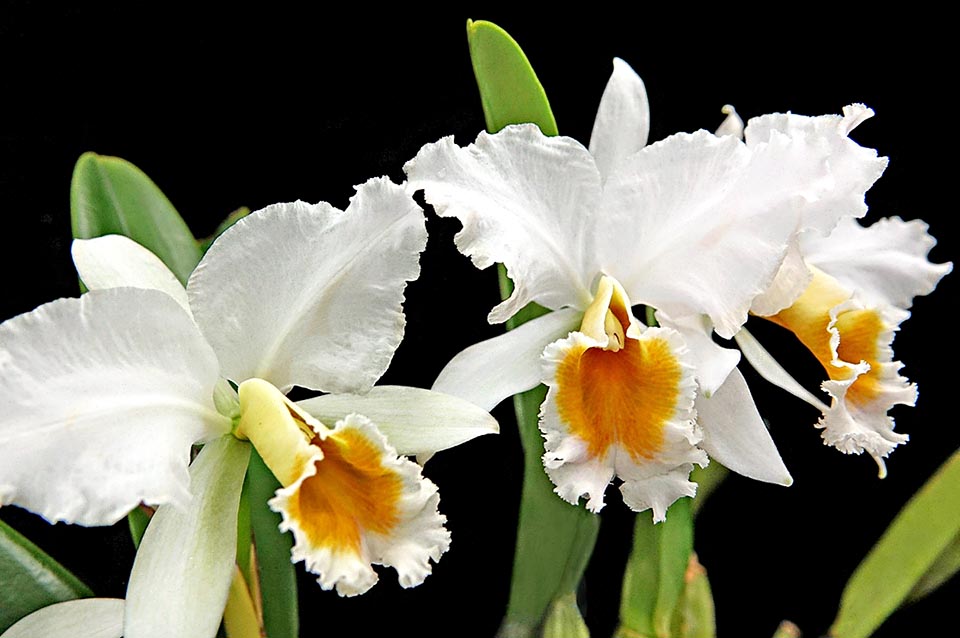
The showy flowers vary from magenta to white like in this Cattleya percivaliana var. alba considered today a synonym of the species © Emmi Mattes
Frederick Sander went berserk because he expected a new species that would have given him more economic income whilst as a variety the commercial value should have been a lot less.
In 1883 the horticulturist James O’Brien (1842-1930), based on his observations on plants flowering in England, raised the variety to the rank of species in the same periodical “The Gardeners’ Chronicle” where Reichenbach mentioned it for the first time. Sander was happy about this and Percival, honoured as having an orchid bearing his name, carried it in various exhibitions and in 1884, one year before his death, got two important merit certificates FCC (First Class Certificate) issued by the “Royal Horticultural Society (RHS)”. One has been granted to a specimen (clone) with intensely coloured big flowers and the other one to a clone with white flowers.
Cattleya percivaliana is a commercially protected species because its natural populations have decreased in a quite significant way due to the intensive collection and due to the destruction of the habitat.
As such it tha been inserted in the Appendix II of Washington Convention (CITES) whose purpose is to protect the animal and vegetable species under risk of extinction, forbidding their export and their detention.
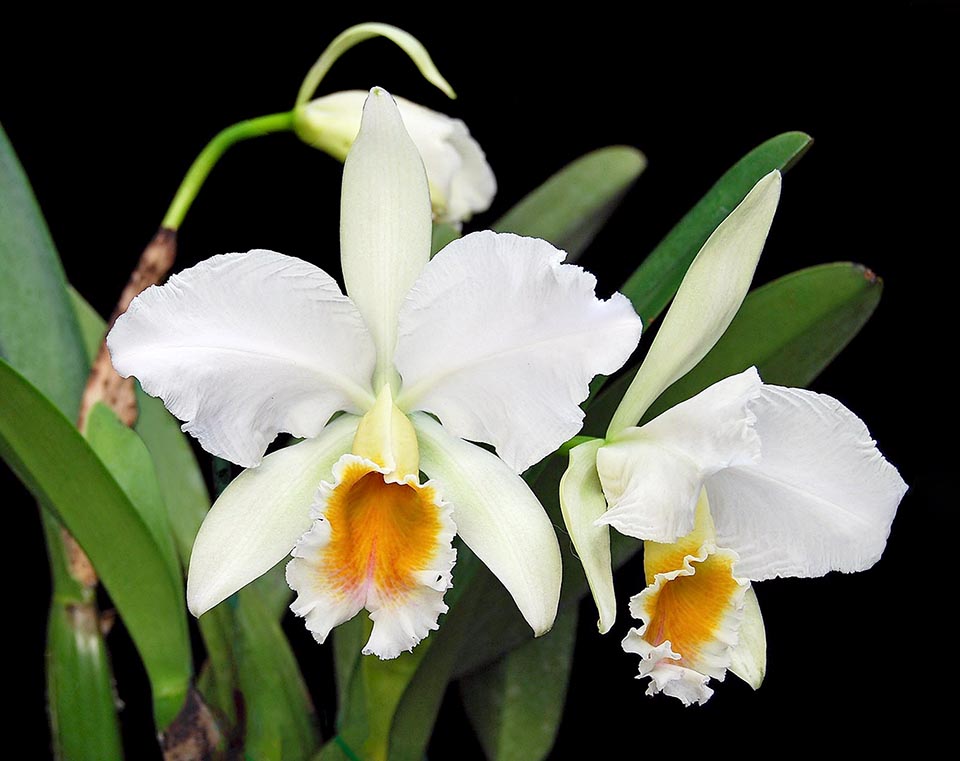
Due to this candid look we talk also of a Cattleya percivaliana forma albescens © Matt Bond
The name of the genus Cattleya, was given in honour of Sir William Cattley (1788-1835), English patron of the floriculture and one of the first to realize in England a rich collection of exotic orchids. The specific epithet, as mentioned before, was dedicated to Mr. R. P. Percival. It is commonly known as “Christmas Orchid” or as “Percival’s Cattley”.
Cattleya percivaliana is a plant with sympodial growth, lithophyte, rarely epiphyte, 20-40 cm tall, with rather fleshy roots, with green and bright spots, able to absorb the water from the air thanks to their upper spongy and permeable superficial layer, formed by dead cells (velamen). The pseudobulbs are clavate, 10-12 cm long, wider at the centre, green with only one leaf, strictly oblong-elliptical, rigid, sub-erect, obtuse, 20-25 cm long.
In order to reduce the waste of water, this species, like many others of the family, has adopted the photosynthesis of CAM (Crassulacean Acid Metabolism) type, process taking place with closed stomata opening only the night for the gas exchanges (CO2, O2) with a minimum waste of water vapour.
The inflorescence, formed by 2 to 4 or more flowers, is racemose, terminal, partially wrapped by a large basal sheath long up to 25 cm.
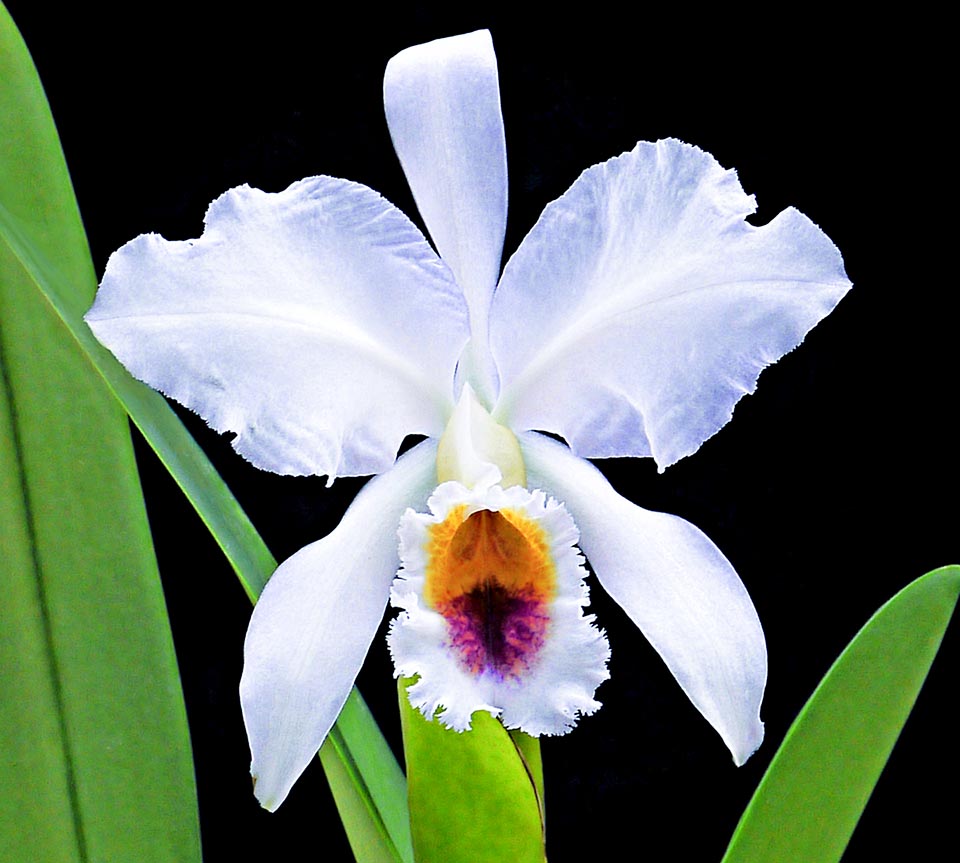
Cattleya percivaliana coerulea is a very rare variety with slightly bluish petals and sepals, purplish labellum with ochre throat and yellow fauces © Emmi Mattes
The flowers, with a diameter of about 12 cm, have violet to pale violet petals, but even of lavender or lilac colour (white in some varieties), and the sepals are often a little clearer. The labellum, shaped like a trumpet, whose anterior lobe is of crimson purple colour, tinged with brown and flecked with yellow, darker inside.
The pollinia, like other species of the genus, are four. The fruit is a capsule containing many tiny seeds.
The. flowers are known for their particular spicy fragrance that borders on the smell of the stink bugs. In fact, often, injured insects emit particular, repulsive, smells, but that may be detected by other organisms they feed of, like, for instance, the wasps, because attracted by the smell that simulates the prey, but in the meantime, without any reward, the plant ensures its progeny.
A study on the nectars has evidenced that on the tepals of Cattleya percivaliana are present nectars.
The chemical analysis of the exudates of these nectars has shown the presence of fructose, glucose and sucrose. According to some Authors these floral nectars are found in the plants pollinated by insects (usually pollinating bees), birds and bats. After other Authors it seems that there is no relation at all between the sugary contents of the exudates and the pollinators.
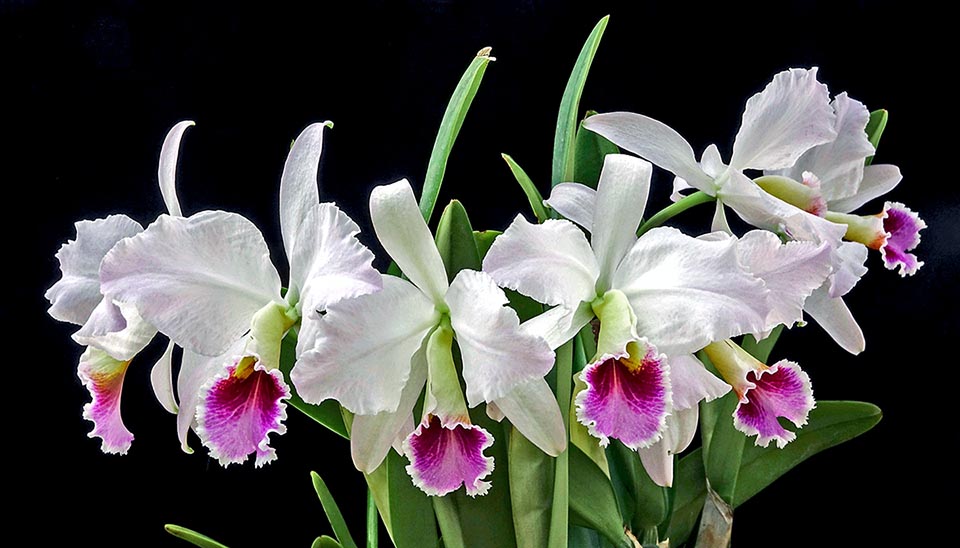
Cattleya percivaliana var. semialba has symmetric white petals and sepals with a nice labellum in a pinkish hue contrasting with the pale edge © Emmi Mattes
It is known, in fact, that the attractors for the pollinators are the scent, the shape and the colour of the flower. Conversely, these exudates may attract ants that eat them but in the meantime may repel animals dangerous for the plant (parasites).
The period of blooming of this orchid varies depending on the latitudes. In Venezuela it flowers in the month of October, in the USA it begins blooming in November, in Europe in December-January. Cattleya percivaliana usually grows vigorously and blooms easily. Its flowers may last up to four weeks. Yore, this species was utilized as a source of cut flowers, but nowadays are preferred the bigger ones obtained from its numerous hybrids.
Being a lithophyte species it may be grown in pot utilizing a cultivation ground formed by a mix of 1/3 of bark of pine finely chopped, 1/3 of charcoal in small pieces and 1/3 of crushed stone gravel, with the inclusion of coconut fibre. An excellent drainage must be ensured because the stagnant water causes damage to its roots. To avoid this problem, the cultivation can be done in a basket or stuck to a trunk, but these means would require a bigger quantity of irrigation.
It is good to cultivate it in a semi-sunny position because in our latitudes the midday sun light could cause harm to the leaves.
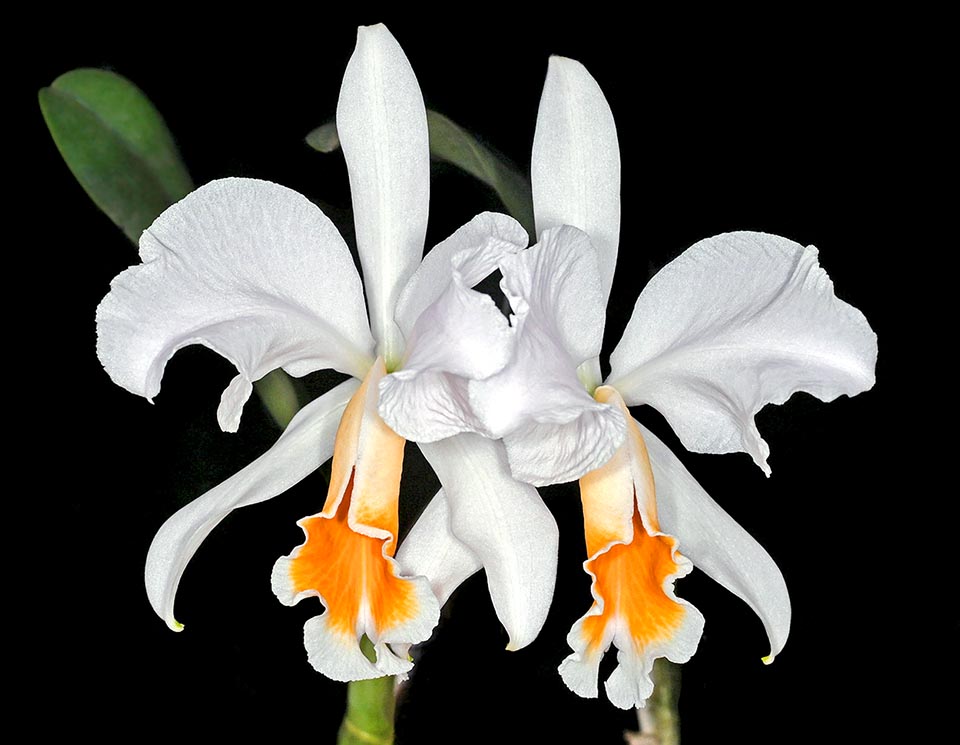
Cattleya percivaliana ‘Graue’ distinguishes for the white greyish petals and showy orange labellum © Ron Parsons
The mean temperatures of the places of origin stand around 23-26 °C the highest and 12-14 °C the lowest, and the humidity is rather high all over the year. It has been observed that in cultivation the plant stands temperatures over the average ones and grows well with environmental humidity around the 80% that may be obtained by installing a simple humidification system.
In autumn and in winter the frequency and the quantity of irrigation should be reduced in order not to cause damage to the roots and to favour the complete ripening of the pseudobulbs.
Every three years it is good to repot, in spring, so that the roots of the new buds may form immediately after. In summer the plant is to be regularly watered and manured by the roots with a mineral fertilizer every two or three weeks in order to stimulate blooming.
Cattleya percivaliana is a splendid orchid with full and flat floral elements, though smaller than those of the other species of the genus. This particular form has been an attraction for the hybridizers who, thanks to these ornamental qualities it has, have used it as parent of multiple varieties and hybrid forms.
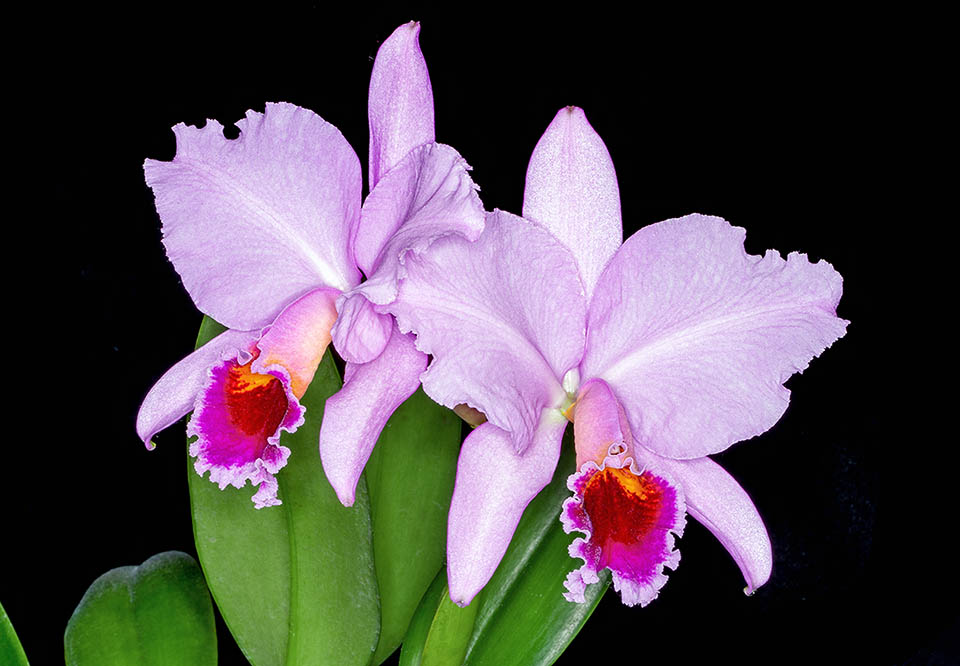
Cattleya percivaliana ‘Summit’ has won 7 awards between 1972 and 2013 for the beauty of the flowers and the big rounded leaves © Giuseppe Mazza
The reproduction may be done by seed, but also in vitro, by micropropagation or by division of the rhizome with at least 3-4 pseudobulbs. Among the very many varieties and cultivars, the most beautiful have the sepals and the petals of an intense pinkish lilac colour that contrasts with the colour of the labellum, very variable, from almost completely purple red to golden yellow with dark lines.
Cattleya percivaliana var. albescens has white petals and sepals and the labellum yellow outside and dark orange inside edged in white.
Cattleya percivaliana var. coerulea is a very rare variety and presents slightly bluish petals and sepals, purplish labellum with throat of ocher colour and yellow fauces.
Cattleya percivaliana var. semialba has symmetrical white petals and sepals with a nice labellum in a pinkish hue contrasting with the clear edge.
Cattleya percivaliana ‘Remolacha’ has white sepals with pink edges, petals white too with pink hues and pink labellum.
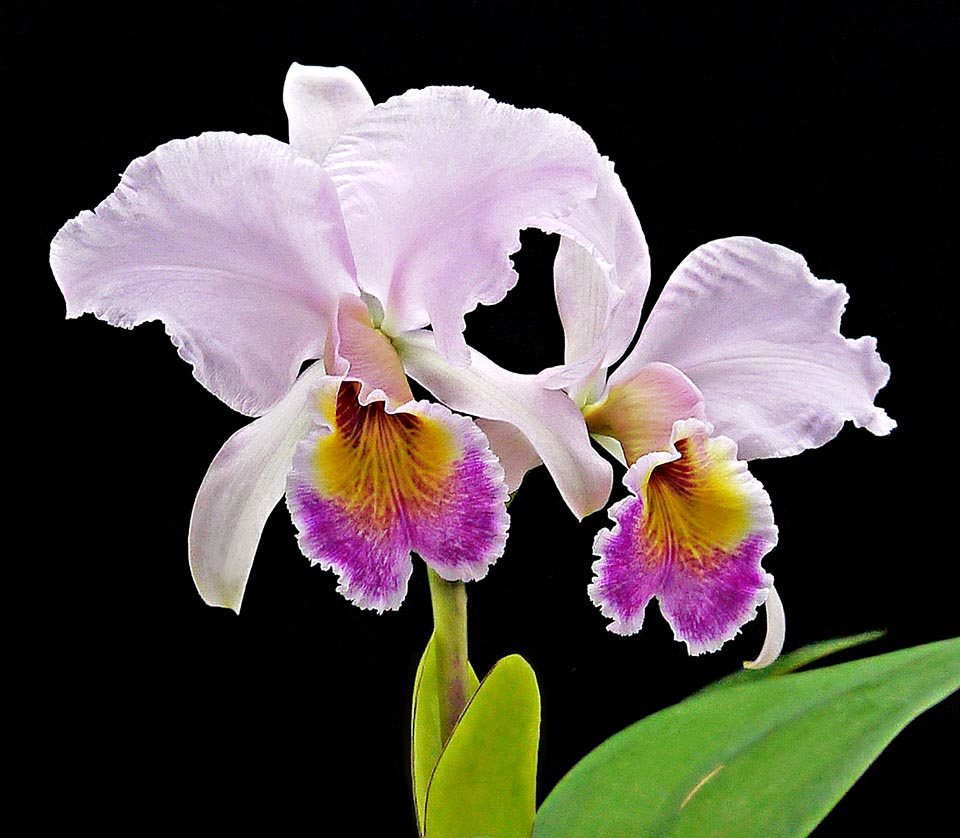
From this last famous orchid was born finally the hybrid Cattleya percivaliana ‘Summit’ x Cattleya rex © Emmi Mattes
Cattleya percivaliana ‘Carache’ has white petals and sepals with labellum intensely coloured like that of the Bordeaux wine.
Cattleya percivaliana ‘Sonia de Urbano’ has white petals and sepals with a weak trace of pink pigment and inside the labellum is of orange colour.
Between the recently awarded cultivars, we mention: Cattleya percivaliana ‘Summit’ (7 awards from 1972 to 2013); Cattleya percivaliana ‘Graue’ (5 awards from 2011 to 2014); Cattleya percivaliana ‘Carla Porto’ (4 awards from 2015 to 2018); with pink petals and sepals; Cattleya percivaliana ‘Nega Chocolate’ (2018) with white sepals and petals and yellow spot on the labellum; Cattleya percivaliana ‘Sublime’ (2018);
Cattleya percivaliana ‘Amalia’ (2017); Cattleya percivaliana ‘Sophia’ (2017); Cattleya percivaliana ‘Berggarten’ (2017).
Synonyms: Cattleya labiata var. percivaliana Rchb.f. (1882); Cattleya percivaliana f. alba (R.Warner & B.S.Williams) M.Wolff & O.Gruss (2007); Cattleya percivaliana f. bicolor (Rolfe) M.Wolff & O. Gruss (2007); Cattleya percivaliana var. alba R.Warner & B.S.Williams (1884); Cattleya percivaliana var. bicolor Rolfe (1886); Cattleya percivaliana var. grandiflora Cogn. & A.Gooss. (1903).
